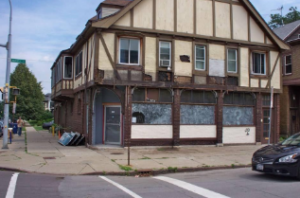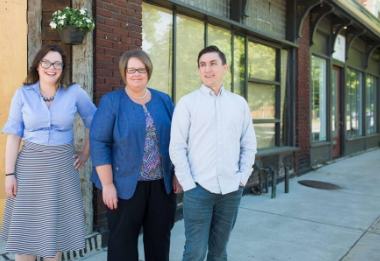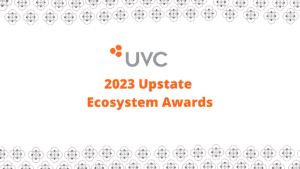If you’ve spent any time in Upstate New York you have no doubt experienced an unfortunate yet common site: a row of empty storefronts lining a street which once upon a time was a bustling town center. Community capital models could be the answer we’ve been looking for to revitalize neighborhoods victim to the rust belt economy.
As Upstate NY’s economy changed, many of these storefronts became boarded up relics—scars on our neighborhoods serving as a reminder of a time since past. It is important to acknowledge that there has recently been significant progress in many upstate communities, but a brisk stroll through Saranac Lake, or Watertown, or even Main Street in Buffalo leaves these scars difficult to ignore. What exactly to do about them, however, is a difficult question.
 Companies like Solar City and IBM may bring much needed jobs to upstate communities, but they don’t necessarily improve our neighborhood centers which have fallen victim to transitioning rust belt economies. No, those commercial strips are better suited for small businesses, coffee shops and art galleries. But with districts that have struggled for decades, it can be difficult to convince local entrepreneurs to take the risk on a storefront that may not have much foot traffic or lure for customers. The old adage that growth begets growth can present an equally perpetuating challenge in the inverse: struggle breeds struggle. And despite recent optimism, we’ve had plenty of struggle in Upstate over the last 60 years. It becomes a vicious cycle requiring a significant catalyst to break. That may be slowly happening as we embrace more innovative markets, but restoring healthy, thriving neighborhoods is as much a key to the long-term success of upstate as attracting and creating high growth companies is.
Companies like Solar City and IBM may bring much needed jobs to upstate communities, but they don’t necessarily improve our neighborhood centers which have fallen victim to transitioning rust belt economies. No, those commercial strips are better suited for small businesses, coffee shops and art galleries. But with districts that have struggled for decades, it can be difficult to convince local entrepreneurs to take the risk on a storefront that may not have much foot traffic or lure for customers. The old adage that growth begets growth can present an equally perpetuating challenge in the inverse: struggle breeds struggle. And despite recent optimism, we’ve had plenty of struggle in Upstate over the last 60 years. It becomes a vicious cycle requiring a significant catalyst to break. That may be slowly happening as we embrace more innovative markets, but restoring healthy, thriving neighborhoods is as much a key to the long-term success of upstate as attracting and creating high growth companies is.
The Parkside neighborhood in Buffalo is no exception to this struggle. I know because it is the neighborhood that my wife and I and our three dogs call home (you read that right—three dogs). As we walk our fur family down Parkside Avenue or Main Street, we can’t help but wonder what must be done to regenerate the struggling commercial districts and neighborhood centers. Three months ago, it led to a remarkable idea: why can’t communities own their commercial centers? Why can’t a neighborhood or a town own a coffee shop, or a theater, or a deli, or a department store? Why can’t civic engagement and capitalism work to make our communities a better place?
After all, one can dream, right?
The truth is I have always been fascinated by the concept of community based capital models. As a first year-associate out of law school I conceptualized a multi-tiered crowdfunding portal “Rust Belt Capital” as a tool for cultivating civic engagement and investing in a local community by the people of that community (I decided to co-found a rum distillery instead). Frankly though, it’s hard not fall in love with the idea—the democratization of capital. The breaking down of walls around investment opportunities and enriching a community. A sort of collective self-determination. It is prime example of what capitalism can be. Or at least what idealistically, many of us hope it can be.
Community ownership of businesses may be extremely rare in New York, but it is common in Great Britain and places where it has been difficult for independent businesses to succeed. My first exposure to community capital was with the Community Store in Saranac Lake—a small village in the Adirondack mountains with approximately 5,000 people. After a local Ames department store closed in 2002, the town was left worrying whether a proposed Wal-Mart store would harm the village’s local proprietors and charm. With the closest department store 40 minutes away, residents decided they would take matters into their own hands—“an investment in the community as well as the store,” remarked Melinda Little in a New York Times article. The Saranac Lake Community Store ultimately raised $500,000 from 600 investors at an average of $800 each. In 2011 after substantial renovations, the store opened, and continues to serve the community to this day.

Having grown up just a few towns over from Saranac Lake, this was a captivating concept to me. it presents a business structure that puts communities and people on an equal footing with profits. And if it can work in an isolated rural community with barely any cell service, why can’t it work elsewhere?
So, imagine my delight when the opportunity presented itself this past spring to help my very own neighborhood create a community owned business model. The idea was not all that dissimilar from Saranac Lake—it was a solution to a void left when a local retailer closed. An acknowledgement of a scar and an opportunity to create an even more vibrant and engaged community with a walkable and more importantly, sustainable commercial district. Parkside Progress, Inc.’s coffee shop named “Jam” aims to do just that by selling shares to bona fide New York residents in and around the Parkside neighborhood.
 In full disclosure, I am the attorney representing Parkside Progress. My wife is the president of the company. My neighbors and friends serve on the board of directors and own shares. The landlord is a neighbor and someone I often find myself enjoying a drink with at our neighborhood pub. Contractors will also likely be neighbors, and employees will be hired from the neighborhood as much as possible. Local vendors will also play a prominent role in the shop—undoubtedly some of them my friends as well. I am sure there are also other disclosures that escape me at the moment, but suffice it to say there are many.
In full disclosure, I am the attorney representing Parkside Progress. My wife is the president of the company. My neighbors and friends serve on the board of directors and own shares. The landlord is a neighbor and someone I often find myself enjoying a drink with at our neighborhood pub. Contractors will also likely be neighbors, and employees will be hired from the neighborhood as much as possible. Local vendors will also play a prominent role in the shop—undoubtedly some of them my friends as well. I am sure there are also other disclosures that escape me at the moment, but suffice it to say there are many.
But that is the point, isn’t it? To be owned by the people who make up your village, town or neighborhood. To create a business model that provides services and products from community to table. To leverage the very fabric that makes so many of our neighborhoods in Upstate New York exceptional places to live, work and play.
And as counter-intuitive as it may be, the time for community based capital has never been better. As international retailers enter a period of mass extinction, markets are being disrupted. Within that disruption, opportunity for competition exists. Local entrepreneurs are stepping up and filling the void left by companies like Sears, the Limited and GameStop. Meanwhile, there is still a very real recognition that brick and mortar stores are a necessary part of the equation for successful communities. Even Amazon recently announced a $13.7B acquisition of Whole Foods Market—marking a major shift for the online retail monopoly as it adds 460 retail locations with highly localized specialty food.
That’s a $13.7B bet that physical retail isn’t dead.
After months of planning and regulatory work with the Attorney General’s office on an intrastate community offering prospectus, Parkside Progress recently announced to the Buffalo News that the company was beginning work on opening “Jam”—a neighborhood owned café in Buffalo’s Parkside neighborhood. “A lot of our neighbors were talking about how they wanted something similar [to what had once been there]” said Amber Small, the Company’s president. After some discussion, Small said, “we decided the best way to see it become something the neighborhood would support is to do it ourselves.”
The opportunity for Upstate communities lies in doing just that.


